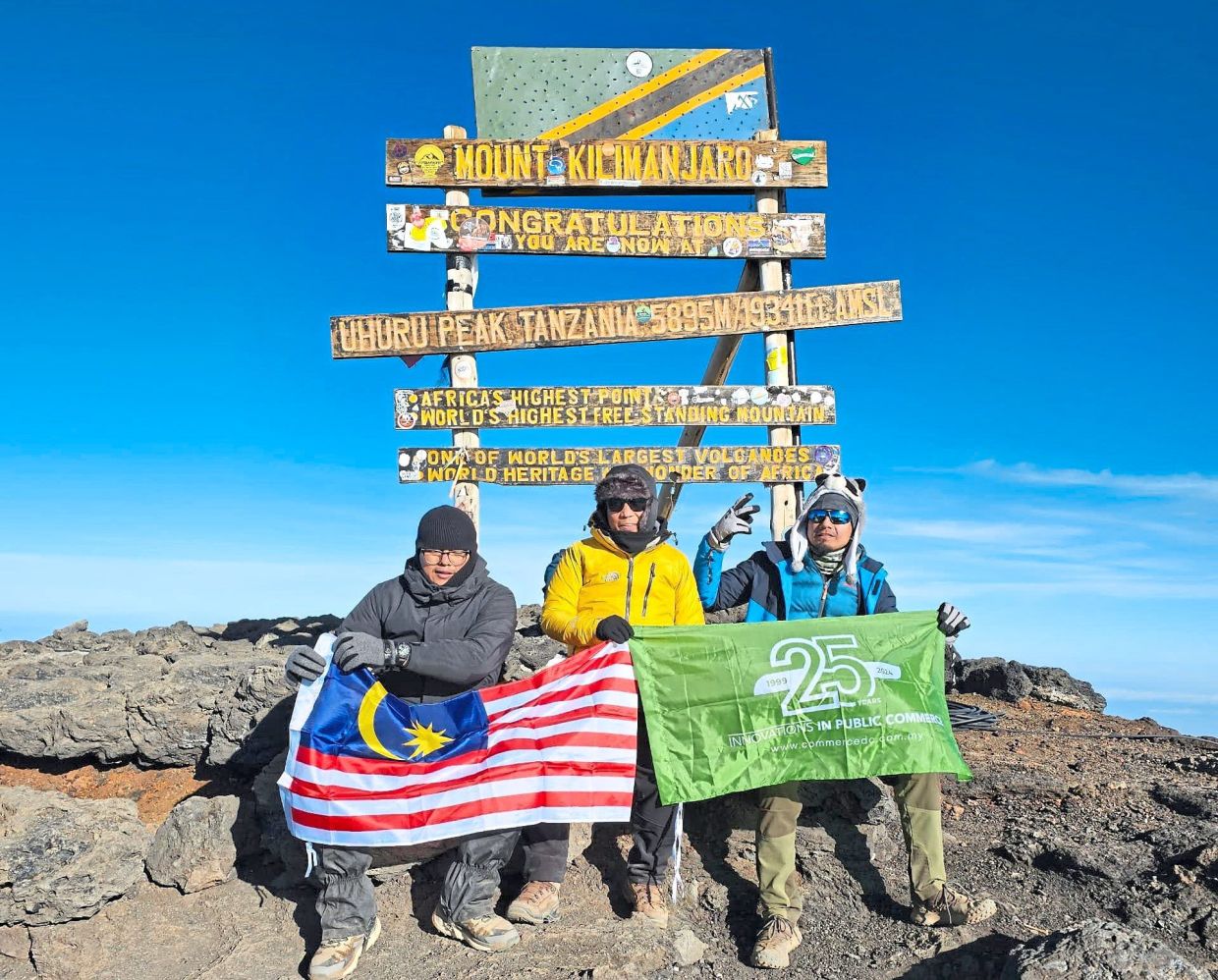(From left) The writer, team leader Datuk Muzafar Kamal Shahaluddin, and Mohd Ghazali Qusai were the first in their team to reach the summit. Photos: Aiman Faqih
I was not planning to do it. Attempting to climb Africa's tallest peak seemed like a wild idea, especially since I’d never climbed anything remotely like it before. But adventure has always called to me.
I slept on the idea after it was first proposed, and realised that if I let this opportunity slip, I would regret it. So, I made up my mind to take on Kilimanjaro.
When I joined Commerce Dot Com, I learned that the company has a tradition of going on climbing expeditions, especially every fifth anniversary. Previously, they’d climbed mountains like Kinabalu, Rinjani, Bromo, and even trekked to the Everest and Annapurna Base Camps. Now, in celebration of the company’s 25th anniversary, the plan was to aim higher.
Joining my teammates, I committed to Kilimanjaro. I wanted to challenge myself, both mentally and physically, in a way most people might not attempt. I felt grateful for my healthy legs, lungs, and the opportunity to experience something extraordinary: The thrill of standing atop Africa’s highest peak.
Climbing Kilimanjaro offered a unique chance to connect with a different culture and witness breathtaking landscapes – from tropical moorlands to alpine deserts and the frozen arctic zone – at the summit. This was far beyond the humid jungles of Malaysia that I had previously explored. I knew it would be cold, but I never thought Africa could be so freezing.
Preparation for Kilimanjaro wasn’t just about physical endurance. It was also about mental fortitude, if not more so. Our team underwent three months of High-Intensity Interval Training (HIIT) to strengthen our cardiovascular system and key muscle groups.
An experienced mountaineer, our guide helped us understand what to expect, offering tips on navigating the physical strain and cold weather. Weekly hikes in the local hills further prepared us, getting our bodies used to steep inclines while camping trips helped us adjust to life without modern comforts.
Most of my teammates and I were not seasoned hikers; we’re just ordinary everyday office workers. A few of us only started hiking this year. But we were determined, and more than excited to take on the challenge.
The moment finally arrived. We began scaling Kilimanjaro on Aug 31. I knew this would be unlike any other experience.
The first two days were a rude awakening as we encountered rain and freezing temperatures, much colder than we expected for that altitude. The drastic temperature drop after sundown, at times dipping below 0°C, made staying warm a constant struggle as we had no fires to keep us warm.
Each morning, our tents were crusted with ice. Our clothing and the hot food were our only protection from the biting cold, but nothing prepared us for the challenges in those conditions.
Bathing was out of the question due to the extreme cold; instead, we made do with wet towels to stay somewhat clean. Even our headlamps struggled in the dense fog.
But the hardest part came during the summit attempt. At -20°C, I pushed through the biting cold, fatigue, and the relentlessness of the climb. The trail ahead seemed endless, and at those altitudes, the lack of oxygen took its toll. AMS (acute mountain sickness) struck, leaving me breathless and weak.
Every step felt monumental, as though I had run miles despite barely moving. My legs wobbled, my hands went numb and doubt started to creep in. At one point, I collapsed, gasping for air. But then, our guide and porter came to my rescue. They kept me moving, offering food and water when I felt I couldn’t take another step.
As the sun started to rise and light began to spill over the horizon, I caught my first glimpse of Stella Point. I felt a renewed sense of strength.
When we finally reached the summit, words failed me. I had pushed through moments when I truly thought I couldn’t continue. And standing at the top of Kilimanjaro, with glaciers towering on either side and the sun rising over a sea of clouds, was beyond anything I had imagined. I felt incredibly small standing there, surrounded by the raw power of nature. That view wasn’t just a reward for reaching the top; it was a reminder of everything we had endured to get there. And in that moment, all the pain, fatigue and doubt melted away.
“Pole pole,” the Swahili phrase meaning “slowly, slowly”, became my mantra. Initially, I thought it was merely advice for avoiding altitude sickness, but I realised it held a broader lesson: Life, like climbing, isn’t about speed; it’s about deliberate, steady progress.
The expedition taught me more than perseverance; it taught me to embrace a positive mindset in the face of adversity. I’ve made deeper connections with my team, and bonded with people outside of my country.
Climbing Kilimanjaro changed me. It gave me a new perspective on future challenges. I had pushed past moments of doubt and discovered resilience within myself. Life’s upcoming hurdles now seem manageable in comparison.
Would I climb Kilimanjaro again? Absolutely. There’s something special about that mountain and I’d love to experience it all over again with new climbers, witnessing their first reactions to its beauty and power.
Perhaps one day I’ll set my sight on Mount Meru – Kilimanjaro’s quieter neighbour – and reflect on the peak that taught me so much. The Kilimanjaro climb was more than just an adventure; it was a lesson in patience, perseverance and taking things “pole pole” – one step at a time.
I wouldn’t have experienced such wonders of the world if it weren’t for the culture of excellence and adventure at the workplace. The Kilimanjaro climb was an incredible challenge, and I’m grateful for every moment of it.











